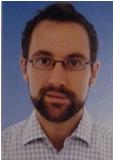Program Information
Brachytherapy QA Employing a High Resolution Liquid Filled Ionisation Chamber Array: Initial Experience and Limitations
M Gainey*, M Kollefrath , G Bruggmoser , University Medical Centre Freiburg, Freiburg Im Breisgau, Baden-Wuerttemberg
Presentations
SU-E-T-150 (Sunday, July 12, 2015) 3:00 PM - 6:00 PM Room: Exhibit Hall
Purpose:
Verifying a complex 3D brachytherapy dose distribution by measurement is non-trivial. Ideally a photon detector array should be independent of energy and angle, have high spatial resolution and be robust for routine clinical use.
Methods:
An iridium-192 source was used. A PMMA jig was constructed comprising an outer slab and a central insert with eight milled channels for 1.33mm (outer diameter) steel needles, see figure. All calculations were performed using an empty CT study reconstructing eight virtual needles (QA-CT), using the v2 source model (Elekta AG, Sweden). A high resolution liquid filled ionisation chamber array SRS1000, together with Verisoft software v6.0 (PTW Freiburg, Germany), was used to perform measurements of plans of increasing complexity to evaluate its suitability for device- and patient-specific QA. The dimension of backscatter material was investigated. The patient plan dwell time distribution was entered manually into the QA-CT and the dose distribution was calculated.
Results:
Our measurements indicate that the array is independent of energy and angle. The resulting measured dose values are linearly interpolated to 2025 values. Shifts of 1mm of the entire needle are readily detectable. Individual dwell position shifts (2.5mm) are also readily measurable. Moreover a dwell time increase of 1 second both in the edge and central region are detectable.
Conclusion:
The high resolution SRS1000 array is a powerful instrument for brachytherapy QA enabling 977 simultaneous measurements to be performed. Our measurements suggest 60mm of RW3 backscatter material upstream and downstream are sufficient. Local percentage difference analysis is useful for device based QA, normalized relative percentage difference is arguably better for patient specific QA. Automated transfer of patient plan dwell time distribution to the QA plan is required to enable a comprehensive patient QA study to be performed. Moreover the described measurement technique can be used for commissioning new brachytherapy applicators.
Contact Email:


